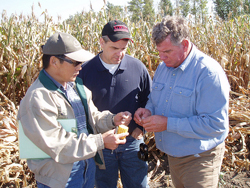 Growth Energy has joined Veyance Technologies, Inc., to seek approval from Underwriter Laboratory (UL) for a liquid fuel hose capable of dispensing ethanol from blender pumps. This is the first ethanol hose to be submitted for UL approval since the lab revised its standards in October 2006 for equipment to carry high-level ethanol blends.
Growth Energy has joined Veyance Technologies, Inc., to seek approval from Underwriter Laboratory (UL) for a liquid fuel hose capable of dispensing ethanol from blender pumps. This is the first ethanol hose to be submitted for UL approval since the lab revised its standards in October 2006 for equipment to carry high-level ethanol blends.
“For the past three years, our efforts to promote an open fuel market where consumers have a choice about what kind of fuel to pump have been stymied by regulatory obstacles to establishing a certified fuel dispensing system,” said Bernie Punt, Growth Energy board member. “Most state and local fire officials require UL certification or similar accreditation. The submission by Veyance Technologies is a landmark step in completing the higher-level blender certification process and opens the market so consumers have more choices of fuel.”
 “Veyance Technologies is pleased to be in a position to make the submission to UL for its review and consideration,” stated Paula Russell, Veyance Technologies. “We have invested significant resources in development of a curb-pump hose and are confident it will meet the robust U.L. standards. We appreciate the financial support being provided by Growth Energy that is allowing us to submit the hose without further delay. The UL certification testing process is expensive and Growth Energy’s financial support has been critical in allowing us to move forward with the effort.”
“Veyance Technologies is pleased to be in a position to make the submission to UL for its review and consideration,” stated Paula Russell, Veyance Technologies. “We have invested significant resources in development of a curb-pump hose and are confident it will meet the robust U.L. standards. We appreciate the financial support being provided by Growth Energy that is allowing us to submit the hose without further delay. The UL certification testing process is expensive and Growth Energy’s financial support has been critical in allowing us to move forward with the effort.”
Punt said that final certification and approval of a curb-pump hose — also referred to as a blender pump — capable of dispensing different grades of ethanol-blended gasoline, is expected by next spring.


 A
A  An E85 promotion will be held at the Holiday Kranz Super Stop at 1185 Main Street South in Sauke Center, Minnesota on Tuesday September 29. The alternative fuel will sell for 85 cents off per gallon from 4 p.m. to 7 p.m.
An E85 promotion will be held at the Holiday Kranz Super Stop at 1185 Main Street South in Sauke Center, Minnesota on Tuesday September 29. The alternative fuel will sell for 85 cents off per gallon from 4 p.m. to 7 p.m. Event Supporters include the Stearns County Corn Growers, Kranz Super Stop (Holiday),
Event Supporters include the Stearns County Corn Growers, Kranz Super Stop (Holiday),  As I
As I  The Department of Energy (DOE) awarded
The Department of Energy (DOE) awarded  According to Cary Sifferath, USGC Senior Director in China, drought conditions in China this year have led to high corn prices. “Those high prices have led to some opportunities for US feed grains products, specifically distillers dried grains (DDGS) products from the US ethanol industry,” Cary said. “We had roughly 8,000 metric tons of DDGS that was exported from the US into China and right now for 2009 we can easily predict 250,000 to 300,000 tons of distillers dried grains being imported by China’s feed and livestock industry, especially in the southern and coastal areas of China where DDGS has become a very competitive feed ingredient.”
According to Cary Sifferath, USGC Senior Director in China, drought conditions in China this year have led to high corn prices. “Those high prices have led to some opportunities for US feed grains products, specifically distillers dried grains (DDGS) products from the US ethanol industry,” Cary said. “We had roughly 8,000 metric tons of DDGS that was exported from the US into China and right now for 2009 we can easily predict 250,000 to 300,000 tons of distillers dried grains being imported by China’s feed and livestock industry, especially in the southern and coastal areas of China where DDGS has become a very competitive feed ingredient.”
 The regulations require large emitters of heat-trapping emissions to begin collecting greenhouse gas (GHG) data under the new program which will cover approximately 85 percent of the nation’s GHG emissions and apply to roughly 10,000 facilities. Ethanol plants were on the list when it was first proposed in March.
The regulations require large emitters of heat-trapping emissions to begin collecting greenhouse gas (GHG) data under the new program which will cover approximately 85 percent of the nation’s GHG emissions and apply to roughly 10,000 facilities. Ethanol plants were on the list when it was first proposed in March.